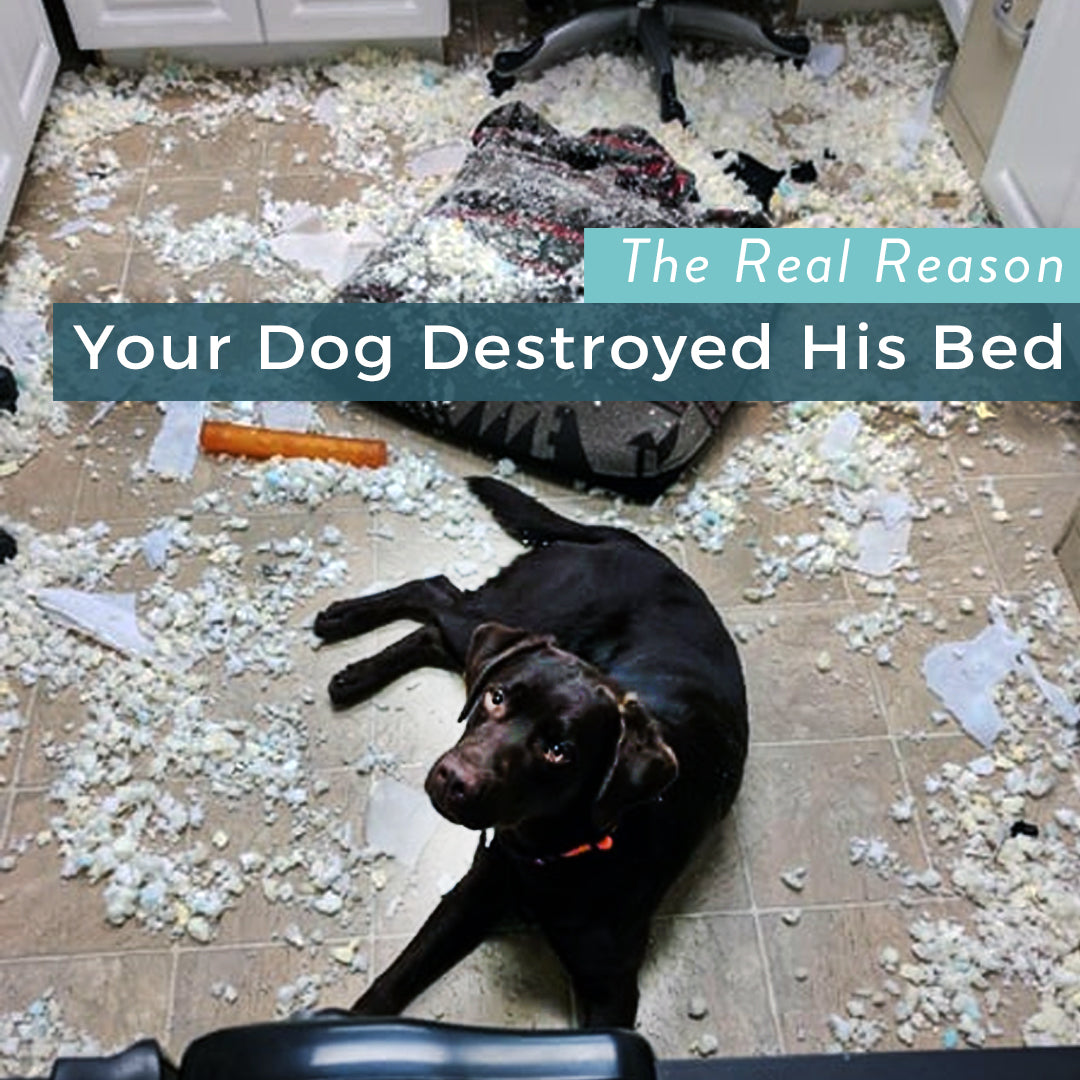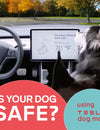
This Is The Real Reason Your Dog Destroyed His Bed
Picture the scene. You come home from work, open the door and find carnage. Your pooch has completely obliterated his bed, which is now nothing more than a pile of fluff and a few scraps of material. To top it off, he’s pooed half-way up the stairs and chewed the remote to pieces too.
What’s your reaction? Do you get angry and blame your dog? Perhaps you even blame the bed! If so, you’re barking completely up the wrong tree. It may be easy to think your dog is acting up to spite you for leaving him home alone, but in actual fact, that couldn’t be further from the truth.
It’s important to realise that your dog isn’t trying to make you angry. As dog parents, our job is to give our pets the attention, affection and love they need - and the reason he’s displaying this destructive behaviour is due to the stress he’s suffering because one of these needs isn’t being fully met.
What’s causing this destructive behaviour?

Accepting that you’re not meeting all of your dog’s needs properly can be a hard pill for any owner to swallow. You probably feel you’re doing everything you can to keep him happy, but still, he behaves in this way. But it’s time to be honest with yourself and look at this from the dog’s perspective. Could it be at all possible that any of the following applies to your dog's situation?
He’s not getting enough exercise

Some breeds need more exercise than others, and that’s especially true if they’re young and boisterous.
As a general rule of thumb, the absolute minimum amount of exercise a dog needs per day is 30 minutes, twice per day. If this exercise is off-lead, that’s even better. But some breeds need even more than this. Border collies, boxers, German shepherds and retrievers are just a few of the dog breeds which need upwards of 2 hours of exercise in total per day!
Are you really fulfilling this need each and every day, 365 days a year? If not, it shouldn’t come as a shock to you when your dog gets his exercise by ripping the house apart instead.
He’s bored while you’re not around
You can’t always be at home, and no one expects you to be. But a bored dog is an unhappy dog, and you need to ensure your dog’s needs are met even while you have to leave the house for short periods.
Do you leave stimulating toys out while you’re gone? Can your dog roam freely around the main part of the house to keep himself busy? If not, you’ll have one bored, frustrated hound on your hands, and there’s no telling what that may lead to!
He just wants something to chew on

Puppies chew. It’s a fact of life. Many dogs continue to chew right into adulthood as the habit continues. That’s why it’s important you offer him something which he is allowed to chew on - before he chews on something he shouldn’t!
Have you taught your dog from an early age what he can chew (and what’s absolutely off-limits)? Dogs, like kids, need boundaries - and it’s down to you to teach him the difference between right and wrong.
Solutions for owners who are struggling to meet their dog's needs

We all have to work, and for most of us, it’s impossible to be there for our dog 24/7. For some people, it may be genuinely difficult to fit in the full amount of exercise their dog needs in a day. But we can’t just leave it at that.
As a dog owner, your dog relies on you to make those walks happen - even if you can’t be there in person to take them with him.
Of course, there are definitely ways to make this happen:
It’s true, the daily cost of a dog walker does add up. But it’s a cost which should be factored in before you even think of acquiring a dog. If you can’t do the walks your dog needs yourself, someone else has to do it - and that’s just a cost you have to bear in order to keep your dog happy and healthy.
Doggie daycare is rapidly increasing in popularity in recent years - and it’s certainly a sure-fire way to burn off some energy in your furry friend. Doggie daycare usually runs from early in the morning until after you finish work (usually 7am-6pm in most cases), and for that time your dog gets the opportunity to race around with their doggie friends for hours on end. You can imagine the result - one very tired doggo with no energy remaining to destroy any part of the house!
Make sure your dog’s not bored when home alone

Of course, there are times when we just need to pop out for a couple of hours as opposed to going out to do a full days work. Times like these shouldn’t require the help of a dog walker or doggie daycare to exhaust your dog just so you can pop to the store. It’s quite reasonable to be able to leave your dog for an hour or so alone.
Invest in a couple of stimulating dog toys, and make sure he has plenty of space to move around and play with them. Kong toys are particularly good for this and can be stuffed with treats to keep him entertained for a good hour or so. There are also various ‘dog puzzle’ toys on the market which work in a similar way.
Separation anxiety could be the cause

If you’ve tried all of the above, but you’re still coming home to mess and destruction on a daily basis, it’s highly likely that separation anxiety is the real culprit.
That’s not to say that you shouldn’t still ensure everything already mentioned isn’t covered. Regardless of the cause of your dog’s destructive behaviour, all of these factors matter and should be addressed as part of your duty as a dog owner.
But when you throw separation anxiety into the mix, you have a much more complex problem on your hands.
What is separation anxiety?

Separation anxiety in dogs is simply your dog missing your company, albeit in an extreme way. For dogs, it isn’t natural for them to be alone. They evolved as pack animals and they crave company. As a family pet, they see you as a pack member - hopefully the alpha! When you go missing for any amount of time, a dog which suffers from separation anxiety will go into meltdown. They don’t understand that you’re going to come back; they only know they’re completely alone, and they don’t even know whether it’ll be forever.
A dog suffering from separation anxiety can display a variety of symptoms. Destructiveness is just one of them - and it could well be the reason why that door has claw marks in it, his bed is ripped to shreds or the carpet has been chewed up.
Other symptoms include barking or howling, inappropriate toileting, chewing, excessive drinking, salivating and pacing around.
As a pet owner, it’s part of our responsibility to try to help them to deal with this anxiety. How we do that is dependant on the severity of the situation, but here are a few useful starting points:
1 - Stop letting him follow you everywhere
Your dog needs to learn to accept that he can’t follow you everywhere, and this should ideally begin in puppyhood. But even if your dog’s fully grown, start as soon as you can. Purchase a dog gate and whenever you’re busy in the house, close him in to a ‘safe area’ where he can still hear you, but can’t get to you. His area should be somewhere he feels safe and secure with familiar smells and perhaps even a cave bed to help him feel at ease.
Don’t make a fuss, just come and go as you please until he understands that you go away… and you return. Increase the time that you leave him behind the gate gradually until he gets used to the idea, and don’t fuss him when you do go near him. He needs to see your return as a ‘non-event’ and not something to get excited about. Make this a daily habit whenever you’re at home.
2 - Begin leaving him for short periods home alone
Once your dog has stopped getting stressed every time you leave the room, it’s time to begin leaving him home alone for short periods of time. Try to keep your dog in the same area as before if at all possible so he can begin to associate that area with ‘downtime’. On the first occasion, leave for just 5 minutes, then 10, then 15 and so on - gradually building up to leaving him for a couple of hours alone at a time.
On each return, do not fuss him until he has settled down and forgotten about the excitement of the moment. Remember, your departure and return should be seen as ‘non-events’ to him. It may be nice to have a dog jump up at you and greet you when you come home, but it’s important you put this feeling aside, as your dog pays the ultimate price with his sanity when you leave if you don’t tone it down like this.
3 - Chew toys are an absolute must
Chewing calms your dog down, so make sure he has plenty of toys he can chew with your blessing. Think of this as the equivalent of a pacifier for an upset toddler. Kongs are great for this - especially filled with treats, but leave a variety of chew toys for him to choose from.
It’s also important that these toys are removed as soon as you return to demonstrate that the best toys only come out when you go out. This helps your dog build a connection between you leaving and fun time starting. You could even make this ‘squeaky toy time’ which is something your dog can genuinely look forward to and learn to associate with time alone - and even better, you can’t hear the squeaks!
4 - Leave the TV or radio on
Some dogs find the sight of the TV and the sound of the radio quite soothing. True, it’s not you, but it is a friendly human voice and familiar music which dampens the deafening sound of silence he will otherwise have to endure without you there. It really can be a great distraction for many dogs.
5 - Enlist the help of a canine behaviourist
If all else fails, this may be a route you have to go down. Canine behaviourists come to your home and look at the issue on a one-to-one basis. They tend to notice the little things you do which could be making the issue worse and will help you to rectify these problems straight away. They really are the fastest way to get to the bottom of the real issue once and for all. Make sure you find a reputable behaviourist, preferably through recommendation.
Over to you!

It can be frustrating when your dog destroys his bed while you’re out, but this frustration is misguided. It’s all too easy to believe that your dog is doing it as some kind of ‘revenge’ to get back at you for leaving him, but that’s simply not the case.
He just wants you near him, he can’t help that. It’s how he’s programmed to feel. But you absolutely can find a way to show him that alone time isn’t something to be feared by following the steps above. Remember, you are your dog’s favourite superhero, don’t let him down!






